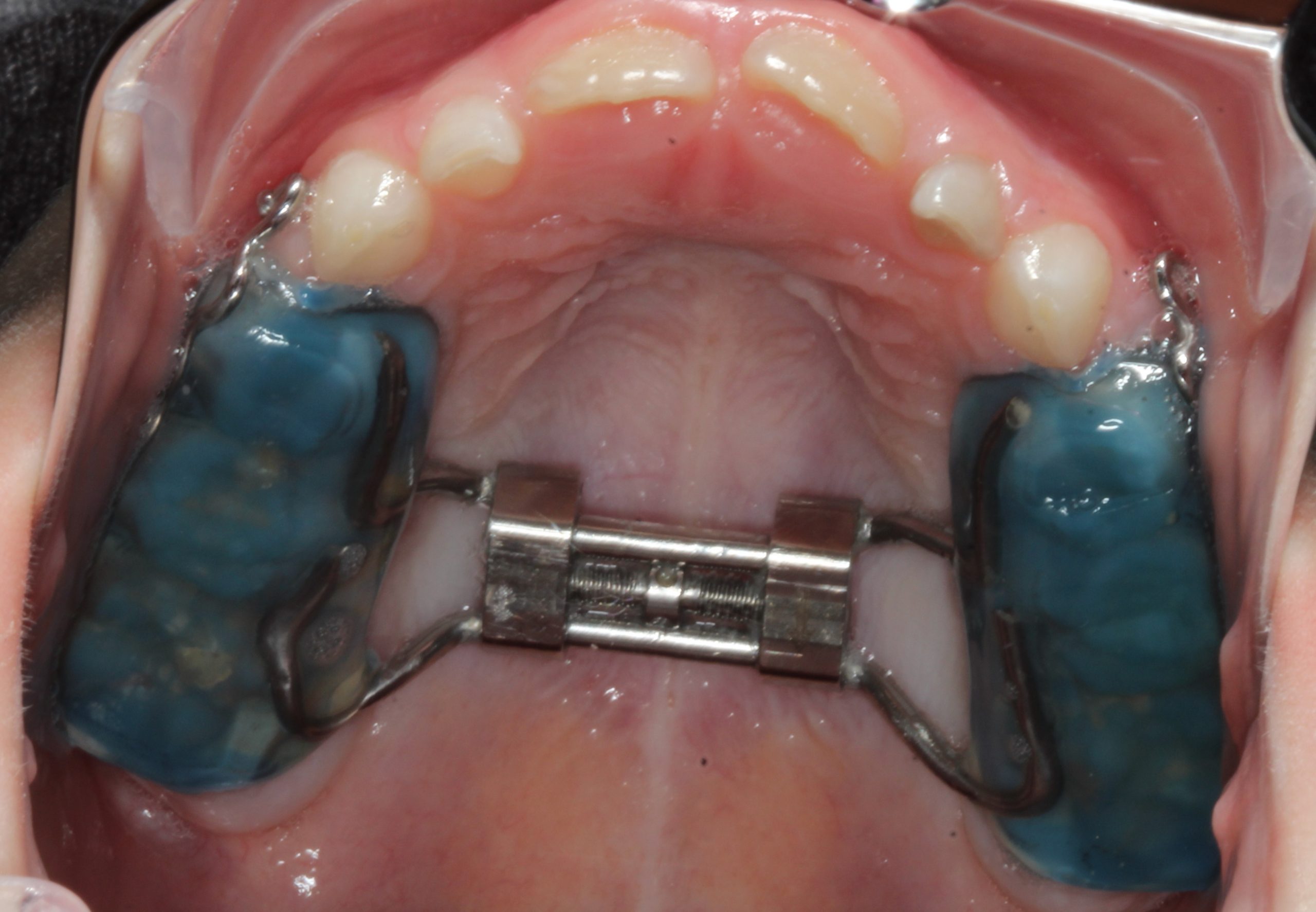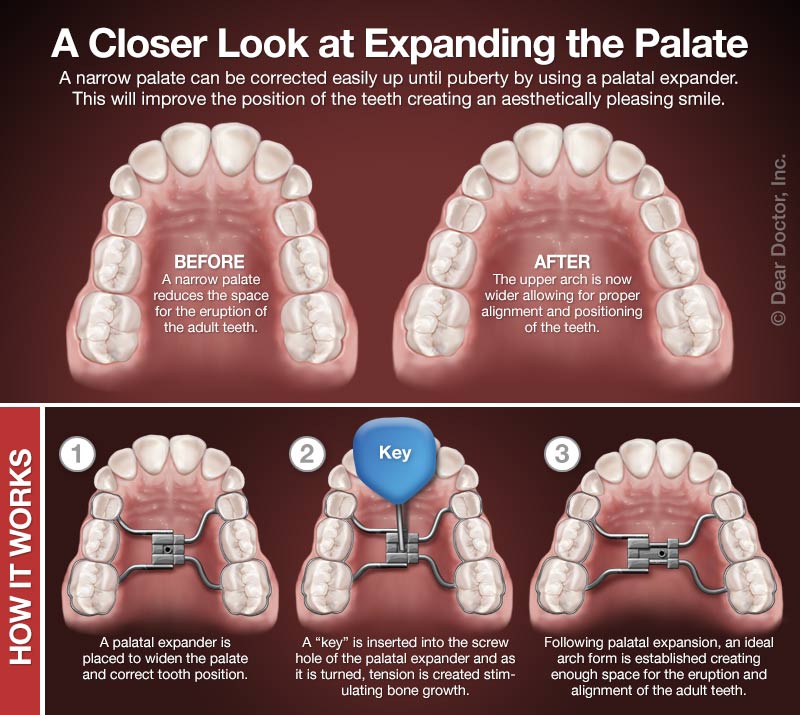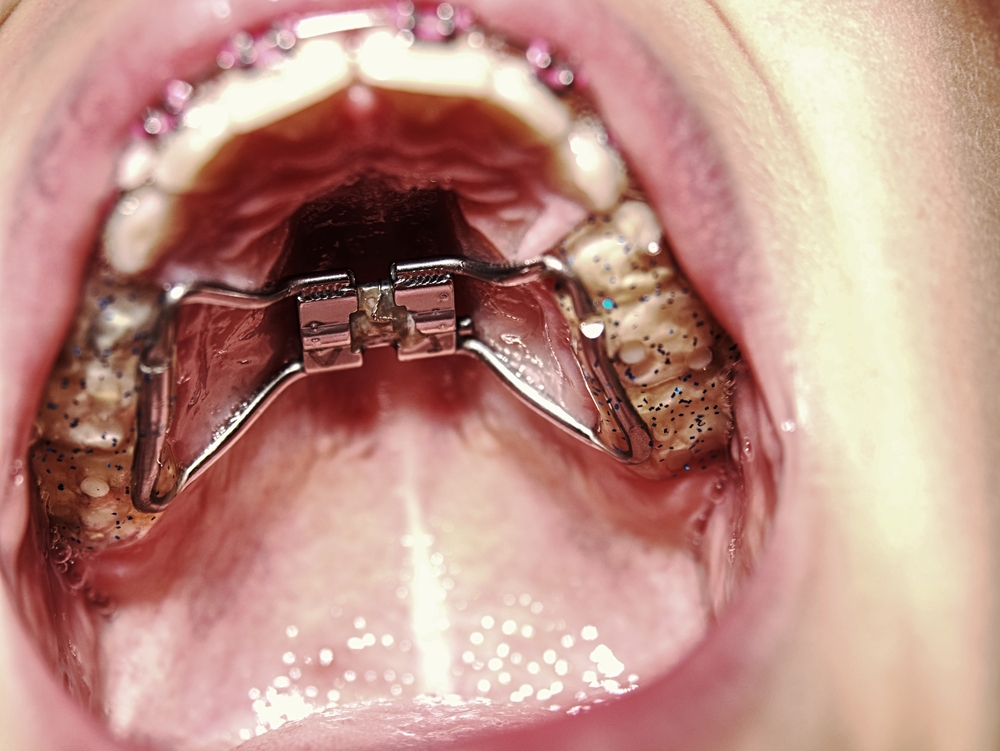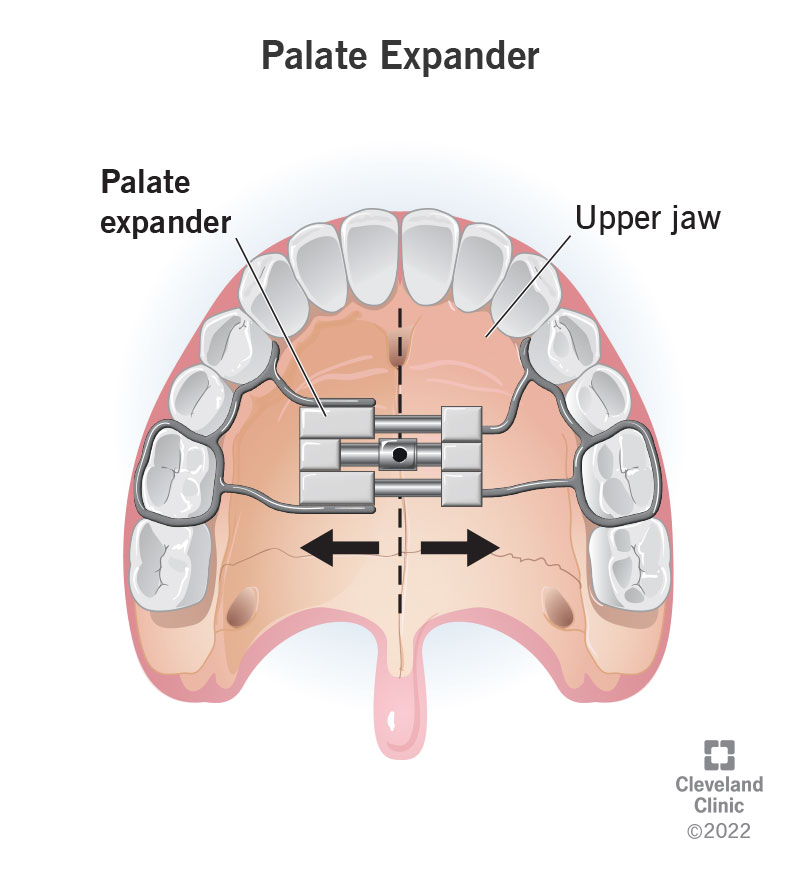To help manage the pain, there are a few strategies you can try. First, it’s recommended to stick to a soft diet for the first few days after activation. This will help minimize any additional discomfort and allow your mouth to adjust more easily. Over-the-counter pain relievers, such as ibuprofen, can also be helpful in reducing any swelling or soreness.
The palate expander procedure is a common orthodontic treatment used to correct issues with the upper jaw and palate. It involves the use of a device that is attached to the roof of the mouth and gradually expands the width of the palate over time. This procedure is typically performed by an orthodontist and is most commonly used in children and teenagers whose jaws are still growing.
How Does a Palate Expander Work?

A palate expander consists of a metal framework that is custom-made to fit the patient’s mouth. It is attached to the molars using bands or rings and has a screw in the middle. The screw is turned regularly, usually once or twice a day, to gradually widen the palate. This process puts pressure on the bones of the upper jaw, causing them to separate and create more space.
Why Is a Palate Expander Used?
A palate expander is used to correct a narrow upper jaw or a crossbite, where the upper teeth sit inside the lower teeth when biting down. By widening the palate, a palate expander helps to create more space for the teeth to align properly. It can also improve breathing and speech, as a narrow palate can sometimes lead to issues with these functions.
What Are the Benefits of a Palate Expander?
The main benefit of a palate expander is that it can correct orthodontic issues and improve the overall function and appearance of the teeth and jaw. By creating more space, it allows for proper alignment of the teeth, which can improve chewing and speech. It can also help to prevent future dental problems, such as overcrowding or impacted teeth.
Is the Palate Expander Procedure Painful?
The palate expander procedure itself is not usually painful, as it is performed under local anesthesia. However, patients may experience some discomfort or soreness in the days following the initial placement of the expander. This is normal and can be managed with over-the-counter pain relief options or natural remedies.
What to Expect During the Palate Expander Procedure
During the palate expander procedure, the orthodontist will first take impressions of the patient’s teeth and jaw. These impressions are used to create a custom-made expander that fits the patient’s mouth perfectly. The expander is then attached to the molars using bands or rings, and the screw is activated to start the widening process. The orthodontist will provide instructions on how often to turn the screw and how long the expander should be worn each day.
| Procedure | Duration | Frequency |
|---|---|---|
| Turning the screw | 5-10 minutes | Once or twice a day |
| Wearing the expander | Varies | As instructed by orthodontist |
How Long Does the Palate Expander Stay in Place?
The duration of palate expander treatment varies depending on the individual case. In general, the expander needs to be worn for several months to achieve the desired widening of the palate. Once the desired expansion is achieved, the expander will be left in place for a period of time to allow the bones to stabilize. After this, the expander will be removed, and the patient may need to wear a retainer to maintain the results.
The Purpose and Benefits of a Palate Expander
A palate expander is a dental device used to widen the upper jaw and create more space in the mouth. It is commonly used in orthodontic treatment to correct issues such as overcrowding, crossbite, and narrow arches. The purpose of a palate expander is to gradually expand the upper jaw, allowing the teeth to align properly and improving overall oral health.
There are several benefits to using a palate expander. Firstly, it can help create enough space for all the teeth to fit properly in the mouth, reducing the need for tooth extraction. This is especially important in children, as it allows their permanent teeth to come in correctly and reduces the risk of future dental problems.
Additionally, a palate expander can improve the alignment of the upper and lower jaws, correcting issues such as crossbite and overbite. By expanding the upper jaw, it helps create a more balanced bite and improves the overall function of the jaw.
Another benefit of using a palate expander is that it can improve breathing and alleviate symptoms of sleep apnea. By widening the upper jaw, it creates more space for the airway, reducing the risk of airway obstruction during sleep.
Overall, a palate expander plays a crucial role in orthodontic treatment by creating space, improving alignment, and enhancing overall oral health. It is a valuable tool in achieving a beautiful smile and a properly functioning bite.
Common Side Effects of Palate Expanders
Here are some common side effects that patients may experience with palate expanders:
| Side Effect | Description |
|---|---|
| Pain and Discomfort | One of the most common side effects of a palate expander is pain and discomfort. This is typically felt in the roof of the mouth and may persist for a few days after the expander is activated. The level of pain can vary from person to person, but it is generally manageable with proper care and pain relief methods. |
| Difficulty Speaking | Some patients may experience difficulty speaking properly after getting a palate expander. This is because the expander takes up space in the mouth, which can affect tongue movement and speech patterns. With time, most patients adapt and regain their normal speech. |
| Increased Salivation | |
| Pressure and Sensitivity | |
| Mild Irritation | The metal components of the palate expander may cause mild irritation or sore spots on the inside of the cheeks or tongue. This can be managed by applying orthodontic wax to the affected areas. |
How Long Does Palate Expander Pain Last?
When undergoing a palate expander procedure, it is common to experience some level of pain or discomfort. The duration of the pain can vary from person to person, but generally, it lasts for a few days to a couple of weeks.
During the initial days after getting a palate expander, you may experience soreness and tenderness in your mouth. This discomfort is normal and is a result of the pressure exerted by the expander on your palate and teeth. It may feel similar to a dull ache or pressure sensation.
To help manage the pain during this period, it is recommended to stick to a soft or liquid diet. Avoiding hard, crunchy, or sticky foods can help minimize any additional discomfort. Cold foods, such as ice cream or popsicles, can also provide temporary relief by numbing the area.
Additionally, maintaining good oral hygiene is crucial during this time. Gently brushing your teeth and the expander itself can help prevent any buildup of bacteria or food particles that could exacerbate the pain.
Tips for Managing Palate Expander Pain
Experiencing pain or discomfort while wearing a palate expander is not uncommon. However, there are several tips and strategies that can help you manage this discomfort and make the adjustment process more bearable. Here are some tips for managing palate expander pain:
- Take over-the-counter pain relievers: Non-prescription pain medications such as ibuprofen or acetaminophen can help alleviate the pain associated with palate expanders. Follow the recommended dosage instructions provided by the manufacturer or consult your orthodontist for guidance.
- Apply ice packs: Placing an ice pack on your cheeks or lips can help reduce swelling and numb the area, providing temporary relief from pain. Wrap the ice pack in a thin cloth or towel to protect your skin from direct contact with the cold.
- Eat soft foods: Stick to a diet of soft foods that require minimal chewing, such as mashed potatoes, yogurt, soup, or smoothies. Avoid hard or sticky foods that can put additional pressure on the palate expander and cause more discomfort.
- Use orthodontic wax: Apply a small amount of orthodontic wax to the areas of the palate expander that are causing irritation or rubbing against your mouth. The wax creates a barrier between the expander and your soft tissues, reducing friction and discomfort.
- Practice good oral hygiene: Maintaining proper oral hygiene is crucial when wearing a palate expander. Brush your teeth gently and use a soft-bristled toothbrush to avoid irritating the sensitive areas of your mouth. Rinse with a saltwater solution to reduce inflammation and promote healing.
- Stay hydrated: Drinking plenty of water can help keep your mouth moist and alleviate some of the discomfort caused by the palate expander. Sipping on cold water or using a humidifier can also provide relief.
- Communicate with your orthodontist: If the pain persists or becomes unbearable, don’t hesitate to reach out to your orthodontist. They can provide additional guidance, adjust the expander if necessary, or recommend alternative pain management strategies.
Remember, palate expander pain is temporary and will gradually subside as your mouth adjusts to the appliance. In the meantime, following these tips can help make the process more comfortable and manageable.
Over-the-Counter Pain Relief Options
When dealing with palate expander pain, there are several over-the-counter pain relief options that can help alleviate discomfort. These options are easily accessible and can provide temporary relief until the pain subsides.
5. Saltwater rinse: A saltwater rinse can help soothe the gums and reduce inflammation. Mix half a teaspoon of salt in a cup of warm water and swish it around in your mouth for about 30 seconds before spitting it out. Repeat this several times a day to alleviate discomfort.
6. Soft foods: Eating soft foods that require minimal chewing can help reduce discomfort while the palate expander is in place. Opt for foods such as mashed potatoes, yogurt, smoothies, and soup. Avoid hard and crunchy foods that can put pressure on the palate expander and increase pain.
Natural Remedies for Palate Expander Pain
Dealing with palate expander pain can be uncomfortable, but there are several natural remedies that can help alleviate the discomfort. These remedies can be used in conjunction with any prescribed pain relief options or as an alternative for those who prefer a more natural approach. Here are some natural remedies for palate expander pain:
| Remedy | Description |
|---|---|
| Ice Pack | Applying an ice pack to the affected area can help reduce swelling and numb the pain. Wrap the ice pack in a cloth and hold it against the outside of your mouth for 10-15 minutes at a time. |
| Saltwater Rinse | Mixing a teaspoon of salt in warm water and rinsing your mouth with the solution can help soothe any soreness or irritation caused by the palate expander. Repeat this rinse several times a day. |
| Cold Foods and Drinks | Eating cold foods and drinking cold liquids can provide temporary relief from palate expander pain. Opt for ice cream, popsicles, smoothies, or chilled soups. |
| Soft Foods | Stick to a soft food diet to minimize discomfort. Choose foods such as mashed potatoes, yogurt, soup, scrambled eggs, and smoothies. Avoid hard and crunchy foods that can put pressure on the expander. |
| Over-the-Counter Herbal Remedies | Some herbal remedies, such as clove oil or chamomile tea, have natural analgesic properties that can help alleviate palate expander pain. Follow the instructions on the packaging for proper usage. |
| Gentle Massaging | Gently massaging the gums around the expander with clean fingers can help relieve discomfort and improve blood circulation in the area. |
| Relaxation Techniques | Engaging in relaxation techniques, such as deep breathing exercises or listening to calming music, can help distract from the pain and promote a sense of well-being. |
Foods to Avoid with a Palate Expander
1. Sticky and Chewy Foods
2. Hard and Crunchy Foods
Avoid hard and crunchy foods that can put excessive pressure on the expander and potentially cause it to break. Examples of these foods include nuts, popcorn, hard candies, and ice cubes.
3. Tough and Fibrous Foods
Foods that are tough and fibrous can also be problematic with a palate expander. These include tough cuts of meat, raw vegetables, and chewy bread crusts. It is best to cook vegetables until they are soft and cut meat into smaller, more manageable pieces.
4. Carbonated and Acidic Drinks
Carbonated and acidic drinks can erode the enamel of your teeth and increase the risk of cavities. Avoid soda, energy drinks, citrus juices, and other acidic beverages. Instead, opt for water, milk, or non-acidic fruit juices.
5. Spicy and Irritating Foods
Spicy and irritating foods can cause discomfort and inflammation in your mouth. Avoid foods with excessive spices, hot peppers, and vinegar-based sauces. Opt for milder seasonings and sauces instead.
Remember to always follow your orthodontist’s instructions and recommendations regarding diet and oral hygiene when wearing a palate expander. By avoiding these foods, you can help ensure a smooth and successful orthodontic treatment.
Proper Oral Hygiene with a Palate Expander
1. Brushing: Brush your teeth at least twice a day, using a soft-bristled toothbrush. Pay extra attention to the areas around the expander, making sure to clean both the upper and lower surfaces. Use gentle, circular motions to remove plaque and food particles. Consider using an electric toothbrush for more effective cleaning.
2. Flossing: Flossing can be a bit more challenging with a palate expander, but it’s still important. Use a floss threader or orthodontic floss threader to guide the floss under the expander wire. Gently move the floss up and down between your teeth, making sure to clean the sides of each tooth. Be careful not to apply too much pressure to avoid dislodging the expander.
3. Mouthwash: Rinse your mouth with an antimicrobial mouthwash after brushing and flossing. This will help kill any remaining bacteria and freshen your breath. Look for a mouthwash that is alcohol-free and specifically designed for orthodontic patients.
4. Water Irrigation: Consider using a water irrigator, such as a Waterpik, to flush out any debris that may be trapped around the expander. This can be especially helpful in hard-to-reach areas. Adjust the water pressure to a comfortable level and aim the stream of water between your teeth and along the gumline.
By following these proper oral hygiene practices, you can minimize the risk of tooth decay, gum disease, and other oral health issues while wearing a palate expander. Remember to be gentle and take your time when cleaning around the expander to avoid any discomfort or damage.
How to Adjust a Palate Expander
Adjusting a palate expander is an important part of the treatment process. It allows for gradual expansion of the palate, creating more space for the teeth to align properly. Here are the steps to adjust a palate expander:
- Start by washing your hands thoroughly to ensure cleanliness.
- Using a mirror, locate the keyhole on the expander. It is usually located in the center or towards the back.
- Insert the key into the keyhole, making sure it fits securely.
- Gently turn the key clockwise or counterclockwise as instructed by your orthodontist. This will activate the expander and initiate the expansion process.
- Be cautious not to turn the key too forcefully, as it may cause discomfort or damage to the expander.
- After turning the key, remove it from the keyhole and store it in a safe place.
- It is normal to feel some pressure or tightness in the palate after the adjustment. This sensation should subside within a few hours.
- Continue with your regular oral hygiene routine, taking extra care to clean around the expander.
- Follow the instructions provided by your orthodontist regarding the frequency of adjustments. Typically, adjustments are made once or twice a week.
- Keep track of the number of turns made during each adjustment to ensure accurate progress monitoring.
If you experience excessive pain or discomfort during an adjustment, it is crucial to contact your orthodontist immediately. They will be able to assess the situation and provide appropriate guidance or make any necessary adjustments to alleviate the discomfort.
Remember to follow your orthodontist’s instructions carefully and attend regular check-ups to ensure the palate expander is working effectively and achieving the desired results.
What to Do If the Palate Expander Causes Excessive Pain
1. Contact Your Orthodontist
The first thing you should do is contact your orthodontist and let them know about the excessive pain you are experiencing. They will be able to provide guidance and advice on how to manage the pain.
2. Follow Their Instructions
3. Take Over-the-Counter Pain Medication
If your orthodontist approves, you can take over-the-counter pain medication such as ibuprofen or acetaminophen to help manage the pain. Be sure to follow the recommended dosage and consult with your orthodontist before taking any medication.
4. Apply Cold Compresses
Using a cold compress can help reduce swelling and numb the area, providing temporary relief from the pain. You can apply a cold pack or a bag of frozen peas wrapped in a cloth to the affected area for 10-15 minutes at a time.
5. Stick to Soft Foods
Eating soft foods that require minimal chewing can help reduce discomfort. Avoid hard, crunchy, or sticky foods that may put additional pressure on the palate expander and exacerbate the pain.
6. Practice Good Oral Hygiene
Maintaining good oral hygiene is crucial when wearing a palate expander. Brush your teeth and the expander carefully to prevent any food particles from getting stuck and causing irritation or infection.
7. Stay Hydrated
Drinking plenty of water can help keep your mouth hydrated and reduce dryness, which can contribute to discomfort. Avoid sugary or acidic beverages that may irritate the mouth further.
8. Stay Patient
By following these steps and staying in close communication with your orthodontist, you can effectively manage and alleviate excessive pain caused by a palate expander.
How to Communicate with Your Orthodontist about Pain

Here are some tips on how to effectively communicate with your orthodontist about your palate expander pain:
- Be specific: When discussing your pain with your orthodontist, be as specific as possible. Describe the location, intensity, and duration of the pain. This will help your orthodontist understand the problem better and determine the appropriate course of action.
- Keep a pain diary: Consider keeping a pain diary to track your discomfort. Note the times when you experience pain, what activities or foods may have triggered it, and any other relevant details. This information can be valuable for your orthodontist in assessing your progress and adjusting your treatment plan.
- Report any changes: If you notice any changes in your pain levels or any other unusual symptoms, inform your orthodontist immediately. They can assess the situation and make any necessary adjustments to your treatment plan.
- Be patient: Palate expander treatment takes time, and it’s normal to experience some discomfort along the way. Be patient and trust the process. Your orthodontist will work with you to ensure your comfort and progress towards your desired results.
Remember, effective communication with your orthodontist is key to managing your palate expander pain. By being specific, asking questions, and reporting any changes, you can work together to make the treatment process as comfortable as possible.
The Role of Orthodontic Wax in Managing Palate Expander Pain
When undergoing treatment with a palate expander, it is common to experience some discomfort and pain. One effective way to alleviate this pain is by using orthodontic wax. Orthodontic wax is a soft and pliable material that can be applied to the palate expander to provide a cushioning effect and reduce friction against the sensitive tissues of the mouth.
How Does Orthodontic Wax Work?
Orthodontic wax is made from a blend of natural waxes, such as beeswax, and is specifically designed for orthodontic use. It comes in small, convenient packages and can be easily applied to the areas of the palate expander that are causing discomfort.
To use orthodontic wax, start by washing your hands thoroughly to ensure cleanliness. Then, take a small piece of wax and roll it into a ball between your fingers to soften it. Next, place the softened wax directly onto the parts of the palate expander that are causing irritation or pain. Press the wax firmly against the metal or plastic components to ensure it adheres properly.
The Benefits of Using Orthodontic Wax
Using orthodontic wax has several benefits in managing palate expander pain. Firstly, it creates a protective barrier between the palate expander and the sensitive tissues of the mouth, reducing friction and irritation. This can significantly alleviate discomfort and allow for a more comfortable experience during the palate expander treatment.
Additionally, orthodontic wax can help prevent any sores or ulcers from developing on the gums or cheeks. The wax acts as a cushion, preventing the metal or plastic components of the palate expander from rubbing against the soft tissues and causing injury. This is especially important during the initial adjustment phase when the palate expander may feel particularly tight or uncomfortable.
Tips for Using Orthodontic Wax
Here are some tips to keep in mind when using orthodontic wax:
- Apply the wax as needed throughout the day to maintain comfort.
- Remove the wax before eating or brushing your teeth, and reapply it afterward.
- If the wax becomes dislodged or falls off, replace it with a fresh piece.
- Keep the wax clean and free from debris by storing it in a clean container.
- If you run out of orthodontic wax, contact your orthodontist for a replacement.
Potential Complications and Risks of Palate Expanders
2. Irritation and Sores: The metal or plastic components of a palate expander can cause irritation and sores in the mouth. This can be exacerbated by the rubbing of the expander against the soft tissues of the mouth. Orthodontic wax can be used to alleviate this discomfort by creating a barrier between the expander and the mouth.
4. Speech Difficulties: Palate expanders can temporarily affect speech, especially during the initial adjustment period. Patients may experience lisping or difficulty pronouncing certain sounds. However, with practice and time, most patients are able to adapt and regain their normal speech patterns.
5. Tooth Sensitivity: Palate expanders can cause temporary tooth sensitivity, especially when eating or drinking hot or cold foods and beverages. This sensitivity usually subsides once the expander is removed or adjusted.
Long-Term Effects of Palate Expanders on Oral Health
1. Tooth Sensitivity: One of the most common long-term effects of palate expanders is increased tooth sensitivity. This is because the expansion process can put pressure on the teeth and gums, causing temporary discomfort. However, this sensitivity should subside once the treatment is complete.
2. Gum Irritation: Palate expanders can also cause irritation to the gums, especially during the initial adjustment period. This can result in redness, swelling, and soreness. Proper oral hygiene, including regular brushing and flossing, can help alleviate these symptoms.
4. Speech Difficulties: Some patients may experience temporary speech difficulties while wearing a palate expander. This is because the device can interfere with the normal movement of the tongue and palate. Speech therapy exercises may be recommended to help overcome these challenges.
6. Relapse: After the palate expansion treatment is complete, there is a possibility of relapse, especially if proper retention measures are not taken. This means that the expanded palate may gradually shift back to its original position, requiring additional orthodontic intervention.

Dr. Fidel Cann: Esteemed orthodontist with a lifelong dedication to enhancing smiles and oral health. Pioneering expertise, compassionate care.






